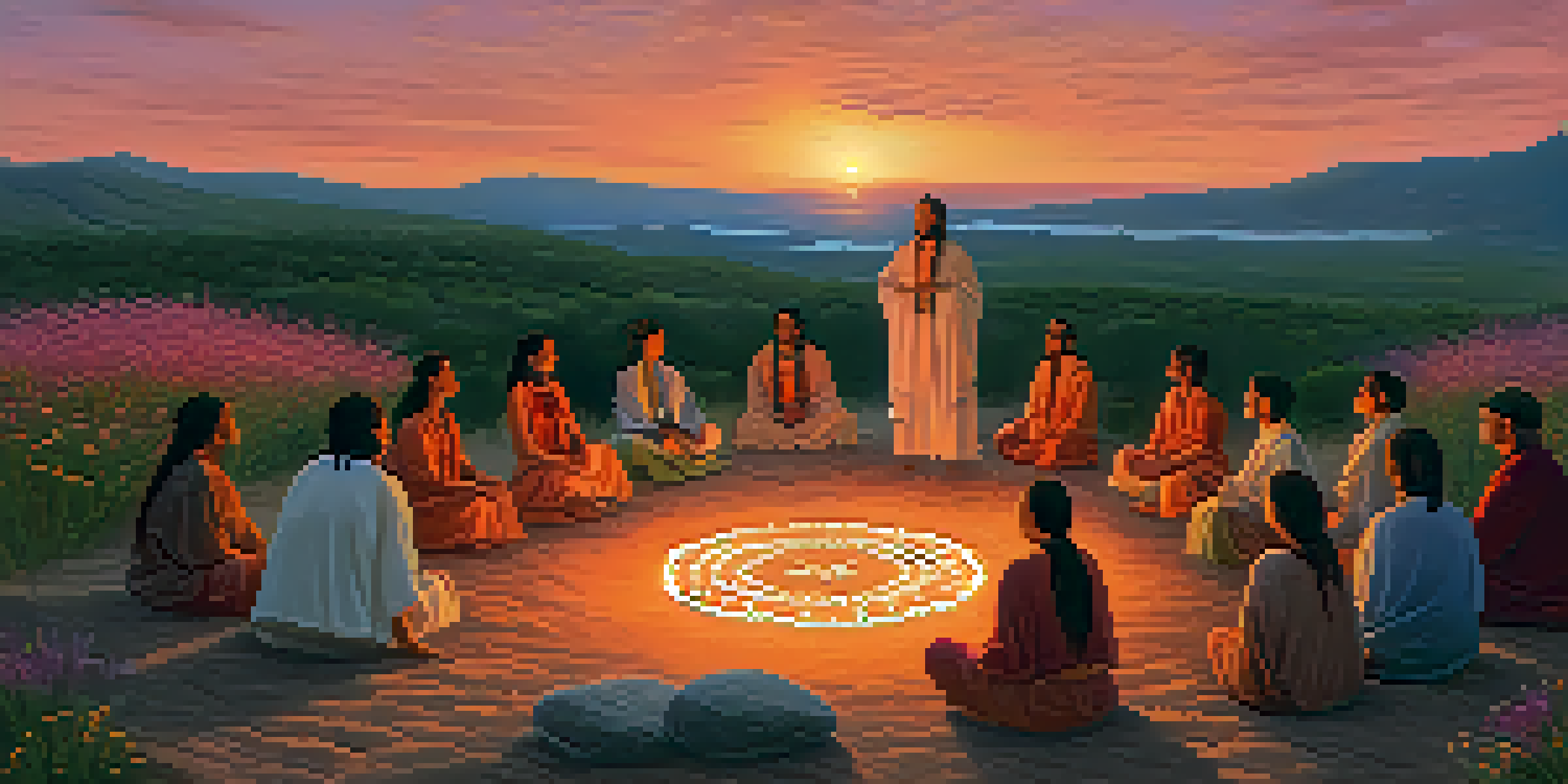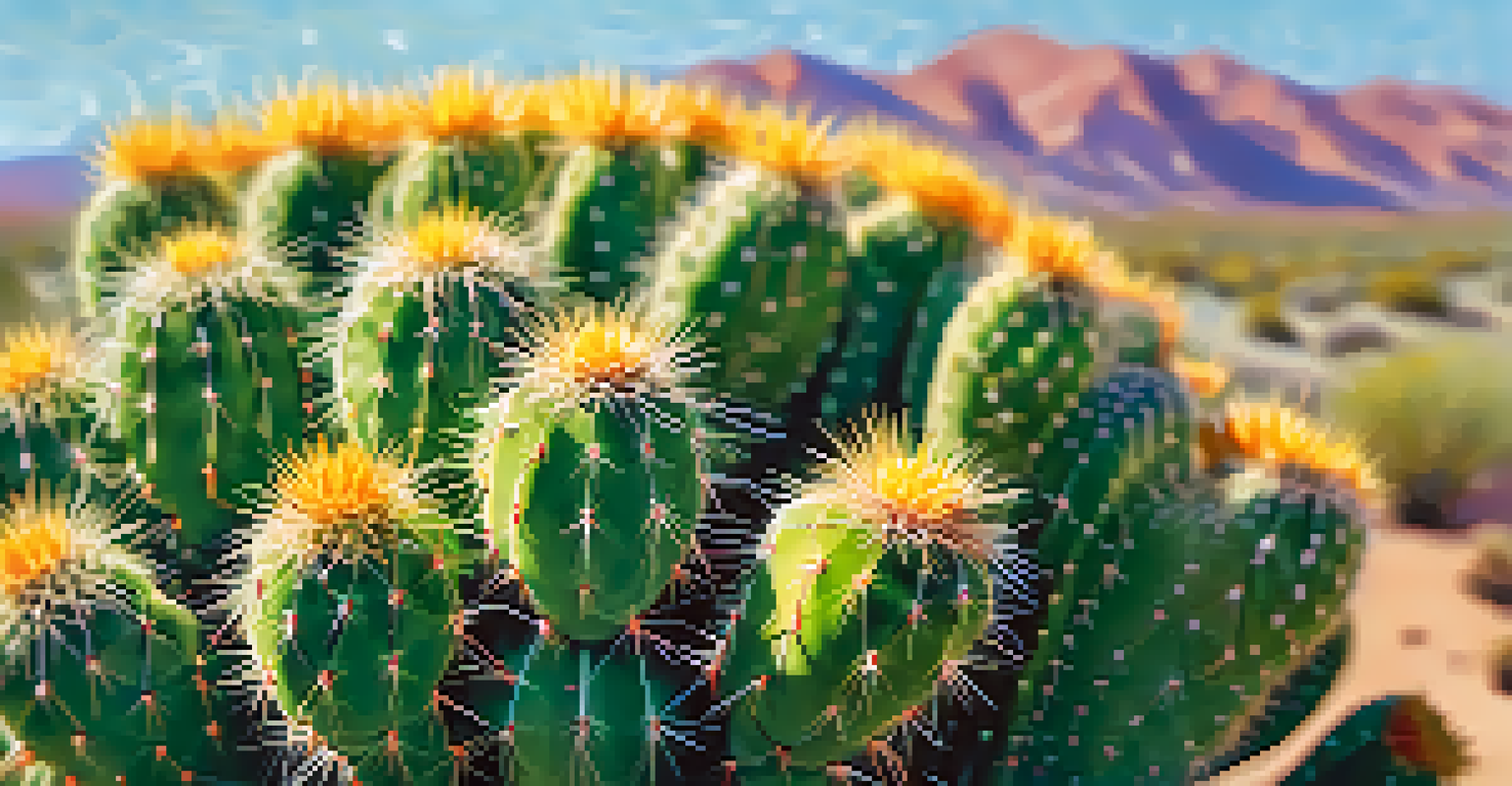Healing Through Peyote: Transforming Trauma into Growth

Understanding Peyote: A Sacred Plant with Healing Powers
Peyote, a small cactus native to Mexico and the southwestern United States, has been used for centuries in various spiritual and healing rituals. Its psychoactive properties are primarily due to a compound called mescaline, which can induce altered states of consciousness. These experiences often facilitate deep introspection and emotional release, making peyote a powerful tool for those grappling with trauma.
The use of peyote in healing rituals represents a profound connection between the plant, the individual, and the community, each playing a vital role in the healing journey.
In many Indigenous cultures, peyote is viewed not just as a plant, but as a sacred ally that helps individuals connect with their inner selves and the universe. This connection can lead to profound insights and a sense of belonging, which are essential for healing. For those who have experienced trauma, this sense of connection can be particularly transformative, offering a pathway toward understanding and reconciliation with their experiences.
As more people seek alternative methods for healing, the use of peyote is gaining recognition beyond traditional settings. However, it’s essential to approach its use with respect and understanding, as it is deeply embedded in the cultural practices of many Indigenous communities. This respect ensures that the healing journey remains authentic and meaningful.
The Science Behind Peyote and Trauma Healing
Research has shown that psychedelics like peyote can significantly impact mental health, particularly in treating trauma-related conditions such as PTSD. When consumed, peyote can alter the brain's chemistry, promoting neuroplasticity—the brain's ability to form new connections. This can help individuals reframe their traumatic experiences and reduce the emotional weight they carry.

Neuroscientific studies suggest that peyote may enhance emotional processing, allowing individuals to confront and integrate difficult memories in a supportive environment. This process can lead to a profound sense of relief and understanding, often described as a 'reset' for the mind. Through this lens, peyote becomes more than just a substance; it acts as a catalyst for deep psychological healing.
Peyote as a Healing Ally
Peyote is revered in many Indigenous cultures as a sacred plant that facilitates deep emotional healing and connection.
Moreover, the communal aspect of peyote ceremonies fosters a supportive environment where individuals can share their experiences. This shared vulnerability helps to break down feelings of isolation and shame, creating a sense of community that is often absent in traditional therapeutic settings. It illustrates how healing can be a collective journey rather than a solitary one.
Personal Stories: Transformative Experiences with Peyote
Many individuals who have engaged in peyote ceremonies report transformative experiences that have helped them navigate their trauma. For example, one participant described how the visions induced by peyote allowed them to confront a painful childhood memory, leading to a breakthrough that unlocked years of pent-up emotion. This cathartic experience became a turning point in their healing journey.
Intention is the foundation of the healing journey; it shapes the experience and guides the path toward transformation.
Another story comes from a veteran who struggled with PTSD after returning from combat. During a peyote ceremony, he found himself reliving moments of his trauma but within a framework of understanding and compassion. The experience not only helped him process his pain but also offered him a new perspective on his life, allowing him to find purpose in his struggles.
These personal narratives highlight the potential of peyote as a healing tool, reinforcing the idea that every journey is unique. The common thread among these stories is the profound sense of connection to oneself and the world, demonstrating how peyote can serve as a bridge to healing and growth.
Preparing for a Peyote Ceremony: What to Expect
Preparing for a peyote ceremony involves much more than simply consuming the cactus; it requires a mindset of openness and respect. Participants are often encouraged to engage in practices such as meditation, journaling, or setting intentions beforehand. This preparation helps create a safe and conducive space for healing to occur during the ceremony.
During the ceremony, participants typically gather in a circle, led by a guide or shaman who facilitates the experience. The environment is often designed to be comforting and supportive, with music, chanting, and the presence of others fostering a sense of community. It's essential to approach the experience with an open heart, as the insights gained can be deeply personal and unexpected.
Science Supports Peyote's Benefits
Research indicates that peyote can enhance emotional processing and promote neuroplasticity, aiding trauma recovery.
Post-ceremony integration is just as crucial as the experience itself. Participants are encouraged to reflect on their journeys, share their insights with trusted friends or therapists, and continue engaging in self-care practices. This integration phase helps solidify the healing gained during the ceremony and allows individuals to carry forward the lessons learned.
The Role of Intention in Healing with Peyote
Intention plays a pivotal role in the effectiveness of peyote as a healing tool. Before entering a ceremony, participants are often encouraged to set clear intentions regarding what they hope to achieve or understand. This focused approach helps guide the experience, allowing individuals to navigate their emotions and memories with purpose.
For instance, someone seeking to heal from grief might express their desire to connect with lost loved ones, while another may wish to confront feelings of anger or shame. These intentions serve as a compass, helping participants stay grounded during the often intense and unpredictable journey of a peyote experience. The more specific the intention, the more targeted the insights are likely to be.
Moreover, intentions can evolve throughout the ceremony, reflecting the dynamic nature of healing. Participants may discover new facets of their trauma or uncover unexpected emotions. This adaptability underscores the importance of remaining open to whatever arises, further enhancing the transformative potential of the experience.
Safety Considerations: Navigating the Peyote Experience
While peyote can offer profound healing, it’s essential to approach its use with caution and responsibility. Not everyone is suited for a peyote experience, especially those with certain mental health conditions or a history of substance misuse. Consulting with a knowledgeable guide or mental health professional can help individuals assess their readiness for such a journey.
It’s also vital to ensure that the ceremony takes place in a safe and supportive environment. This means participating in a gathering led by experienced facilitators who are familiar with the cultural and spiritual significance of peyote. A safe setting encourages trust and openness, allowing participants to fully immerse themselves in the experience without fear.
Importance of Intention in Healing
Setting clear intentions before a peyote ceremony is crucial for guiding the healing experience and maximizing insights.
Lastly, aftercare is crucial. Participants should have a plan for post-ceremony integration, whether through therapy, group sharing, or self-reflection. Recognizing that the healing journey continues beyond the ceremony helps individuals process their experiences and reinforces the positive changes initiated during their time with peyote.
The Future of Peyote in Healing Practices
As the interest in alternative healing methods grows, peyote is increasingly being recognized for its potential benefits in mental health treatment. However, the future of its use hinges on the balance between respect for Indigenous traditions and the need for accessible healing options. This balance is crucial to ensure that peyote remains a sacred tool rather than becoming commercialized.
Ongoing research into psychedelics is paving the way for a broader understanding of their therapeutic applications. As scientific studies continue to emerge, we may see a shift in how society views substances like peyote, moving beyond stigmas and towards a more informed perspective on their potential for healing. This could lead to more structured and supported avenues for individuals seeking healing through peyote.

Ultimately, the future of peyote in healing practices will depend on collective efforts to honor its cultural significance while exploring its therapeutic potential. By fostering respectful dialogue and understanding, we can create pathways for healing that honor both the plant and the people it serves.